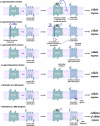Frequent deregulations in the hedgehog signaling network and cross-talks with the epidermal growth factor receptor pathway involved in cancer progression and targeted therapies
- PMID: 20716670
- PMCID: PMC2964899
- DOI: 10.1124/pr.109.002329
Frequent deregulations in the hedgehog signaling network and cross-talks with the epidermal growth factor receptor pathway involved in cancer progression and targeted therapies
Abstract
The hedgehog (Hh)/glioma-associated oncogene (GLI) signaling network is among the most important and fascinating signal transduction systems that provide critical functions in the regulation of many developmental and physiological processes. The coordinated spatiotemporal interplay of the Hh ligands and other growth factors is necessary for the stringent control of the behavior of diverse types of tissue-resident stem/progenitor cells and their progenies. The activation of the Hh cascade might promote the tissue regeneration and repair after severe injury in numerous organs, insulin production in pancreatic beta-cells, and neovascularization. Consequently, the stimulation of the Hh pathway constitutes a potential therapeutic strategy to treat diverse human disorders, including severe tissue injuries; diabetes mellitus; and brain, skin, and cardiovascular disorders. In counterbalance, a deregulation of the Hh signaling network might lead to major tissular disorders and the development of a wide variety of aggressive and metastatic cancers. The target gene products induced through the persistent Hh activation can contribute to the self-renewal, survival, migration, and metastasis of cancer stem/progenitor cells and their progenies. Moreover, the pivotal role mediated through the Hh/GLI cascade during cancer progression also implicates the cooperation with other oncogenic products, such as mutated K-RAS and complex cross-talk with different growth factor pathways, including tyrosine kinase receptors, such as epidermal growth factor receptor (EGFR), Wnt/beta-catenin, and transforming growth factor-beta (TGF-beta)/TGF-beta receptors. Therefore, the molecular targeting of distinct deregulated gene products, including Hh and EGFR signaling components and other signaling elements that are frequently deregulated in highly tumorigenic cancer-initiating cells and their progenies, might constitute a potential therapeutic strategy to eradicate the total cancer cell mass. Of clinical interest is that these multitargeted approaches offer great promise as adjuvant treatments for improving the current antihormonal therapies, radiotherapies, and/or chemotherapies against locally advanced and metastatic cancers, thereby preventing disease relapse and the death of patients with cancer.
Figures






Similar articles
-
Epidermal growth factor receptor signaling synergizes with Hedgehog/GLI in oncogenic transformation via activation of the MEK/ERK/JUN pathway.Cancer Res. 2009 Feb 15;69(4):1284-92. doi: 10.1158/0008-5472.CAN-08-2331. Epub 2009 Feb 3. Cancer Res. 2009. PMID: 19190345 Free PMC article.
-
Frequent gene products and molecular pathways altered in prostate cancer- and metastasis-initiating cells and their progenies and novel promising multitargeted therapies.Mol Med. 2011 Sep-Oct;17(9-10):949-64. doi: 10.2119/molmed.2011.00115. Epub 2011 May 20. Mol Med. 2011. PMID: 21607288 Free PMC article. Review.
-
New advances on critical implications of tumor- and metastasis-initiating cells in cancer progression, treatment resistance and disease recurrence.Histol Histopathol. 2010 Aug;25(8):1057-73. doi: 10.14670/HH-25.1057. Histol Histopathol. 2010. PMID: 20552555 Free PMC article. Review.
-
Complex oncogenic signaling networks regulate brain tumor-initiating cells and their progenies: pivotal roles of wild-type EGFR, EGFRvIII mutant and hedgehog cascades and novel multitargeted therapies.Brain Pathol. 2011 Sep;21(5):479-500. doi: 10.1111/j.1750-3639.2011.00505.x. Epub 2011 Jul 7. Brain Pathol. 2011. PMID: 21615592 Free PMC article. Review.
-
Altered gene products involved in the malignant reprogramming of cancer stem/progenitor cells and multitargeted therapies.Mol Aspects Med. 2014 Oct;39:3-32. doi: 10.1016/j.mam.2013.08.001. Epub 2013 Aug 29. Mol Aspects Med. 2014. PMID: 23994756 Free PMC article. Review.
Cited by
-
Aberrant Hedgehog ligands induce progressive pancreatic fibrosis by paracrine activation of myofibroblasts and ductular cells in transgenic zebrafish.PLoS One. 2011;6(12):e27941. doi: 10.1371/journal.pone.0027941. Epub 2011 Dec 2. PLoS One. 2011. PMID: 22164219 Free PMC article.
-
Curcumin induces therapeutic angiogenesis in a diabetic mouse hindlimb ischemia model via modulating the function of endothelial progenitor cells.Stem Cell Res Ther. 2017 Aug 3;8(1):182. doi: 10.1186/s13287-017-0636-9. Stem Cell Res Ther. 2017. PMID: 28774328 Free PMC article.
-
Reduced Granule Cell Proliferation and Molecular Dysregulation in the Cerebellum of Lysosomal Acid Phosphatase 2 (ACP2) Mutant Mice.Int J Mol Sci. 2021 Mar 15;22(6):2994. doi: 10.3390/ijms22062994. Int J Mol Sci. 2021. PMID: 33804256 Free PMC article.
-
EGFR/ARF6 regulation of Hh signalling stimulates oncogenic Ras tumour overgrowth.Nat Commun. 2017 Mar 10;8:14688. doi: 10.1038/ncomms14688. Nat Commun. 2017. PMID: 28281543 Free PMC article.
-
Inhibition of hedgehog signaling improves the anti-carcinogenic effects of docetaxel in prostate cancer.Oncotarget. 2015 Feb 28;6(6):3887-903. doi: 10.18632/oncotarget.2932. Oncotarget. 2015. PMID: 25682877 Free PMC article.
References
-
- Ahn S, Joyner AL. (2005) In vivo analysis of quiescent adult neural stem cells responding to sonic hedgehog. Nature 437:894–897 - PubMed
-
- Alvarez-Medina R, Le Dreau G, Ros M, Martí E. (2009) Hedgehog activation is required upstream of Wnt signalling to control neural progenitor proliferation. Development 136:3301–3309 - PubMed
Publication types
MeSH terms
Substances
Grants and funding
LinkOut - more resources
Full Text Sources
Research Materials
Miscellaneous

